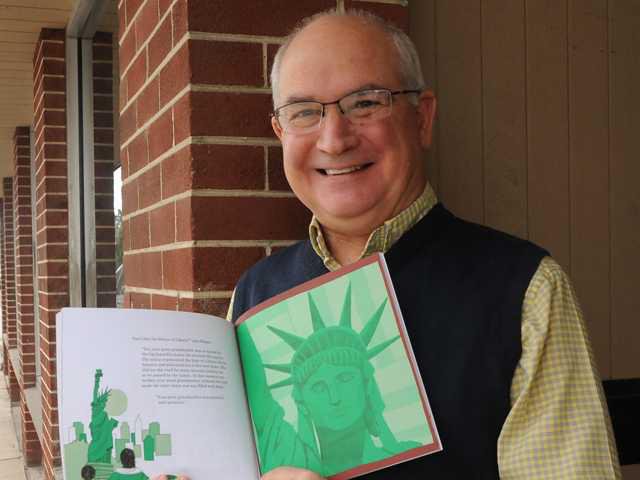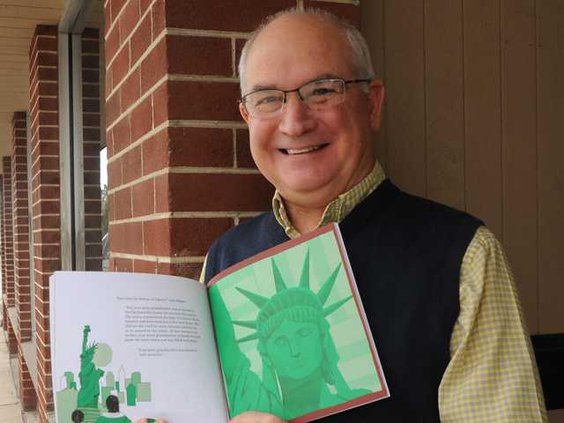“The Napping Quilt” – a family’s story of immigrating to America from their native Italy — is the work of novice children’s book writer Gary Dei Rossi.
It centers around a family quilt that was sewn by Dei Rossi’s great grandmother on her journey to the United States in the horrific bowels of a steam ship that sailed from Genoa to New York and then across America to San Francisco by train.
Dei Rossi is a retired deputy superintendent of the San Joaquin County Office of Education. His book focuses on his family’s journey to America and the personal character that was necessary for them to reach their goals.
Each square in the Napping Quilt tells a part of the journey. Dei Rossi said the book is dedicated to all the immigrants who came to America to create a better life for themselves and their families. Dei Rossi said their contributions to this nation have forged its greatness.
“People in our family have taken naps under this quilt for almost 70 years,” Dei Rossi notes in the book. “It brings warmth, comfort and tells about the journey our mother and great grandmother made in coming to this country. On the quilt there are 12 squares that have descriptive designs of a very long journey on them. Each describes a part of our life and our journey to America,”
The first square in the quilt shows the great grandmother’s hometown that reminded her of swimming in the river on hot days in the cool blue water. It included a bridge where she would race her brothers from one end to the other.
The second square showed the buildings she remembered in her town square with her church, the courthouse and stores where her family shopped. Yet another was a depiction of the town square where her family bought their vegetables and buildings made of stone.
Another square was stitched together showing two people riding bicycles in the countryside. Actually, their great grandmother and her future husband were the couple as few people had cars in the early part of the 20 th century. A side note explained that the great grandmother was affectionate and thrifty.
Probably the most impressive square was a large steam ship that the great grandmother took by herself to sail across the Atlantic Ocean. She had to leave her home in Italy because there were no jobs and not much food to eat.
The next square in the quilt showed a single flat mattress on the floor where the great grandmother slept using the quilt for warmth in the depth of the ship’s cold and dreary cargo area on the bottom deck. There were no excursions, no buffets, no entertainment and the days and nights were long and cold.
And finally a square that she sewed by hand showing the Statue of Liberty as the ship sailed into New York harbor that represented her hope for a new life in her new country with Lady Liberty welcoming her in to her new home.
Another square featured the endless brown waves depicting the endless fields of wheat in the Great Plains.
A square representing San Francisco – the great grandmother’s new hometown – had beautiful parks, museums and cable cars and wonderful restaurants.
The last square in the quilt depicts her expectations of the future generation she knew would follow her in life – a life that she hopefully would be better for them because of her sacrifices in overcoming the challenges of an exhausting trip to the new world.
Dei Rossi’s summation of his children’s book is that “literature is really powerful in the early years and can have an impact on children and who they want to be someday.”
His grandfather had come to America in 1913 and fell in love with the country. He liked the fact that if you worked hard you could get ahead, Dei Rossi said. But his great grandfather had turned ill and needed him to return to Italy and run the farm for the rest of the family.
Dei Rossi added that to make matters worse, Mussolini had come into power and his grandfather was assisting the freedom fighters. He said his grandfather was going to come back to America but then the German Nazis took over his country. He was arrested and put in jail. The only food available was what family members would bring to the prison. Relatives would take the train to take him food.
He said it was a time in Italy when the enemy aircraft would fire on the trains. Passengers would be urged to run from the train as it stopped on the tracks for them to flee. When pilots saw the people running they knew it was not a cargo train and would not fire on it or bomb it, he said.
The great grandfather was in prison four to five months and released only because they didn’t have enough evidence to keep him behind bars, Dei Rossi said. When the American forces began to close in, the Germans stole valuables from the citizenry. The resistance came along and captured the Germans and took back the stolen items from jewelry to portraits and furniture.
Seeing they were going to sell the many spoils on the black market, he told the men that they needed to give everything back to the people of Italy. He was shot in the side for his persistence and due to the absence of penicillin for his wound, he died 11 days later.
Vittirio Dei Rossi was in his 40s when he died and a plaque in his honor was mounted in the town in 1948 when Dei Rossi’s Dad went back to visit his homeland. The whole family returned for a visit in 1970, but Dei Rossi noted that the bad feelings against Germans and Americans still persisted in the countryside.
Dei Rossi welcomes any schools wishing him to visit their campus and read his books to children in their classrooms. He has been a classroom teacher, a vice principal, principal and district office administrator as well as a university adjunct professor. He earned his BA in History from UCLA and his masters in School Management from the University of LaVerne and a doctorate from the University of the Pacific in Educational Administration.
During his career he was involved in early childhood education and history-social science curriculum development. The book is available on Amazon for $12.93.
To contact Glenn Kahl, email gkahl@mantecabulletin.com.
THE NAPPING QUILT
Retired educator shares his familys story in book for children



